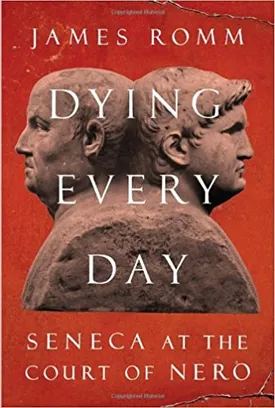Dying Every Day: Seneca at the Court of Nero by James Romm
Dying Every Day: Seneca at the Court of Nero by James Romm is a meticulously researched biography of the philosopher and statesman, Lucius Annaeus Seneca. A contemporary of the Roman emperor, Nero, Seneca was one of the most influential figures of his time and a major figure in the evolution of philosophical thought. This book offers an in-depth look at the life of Seneca and how his rise in the court of Nero ultimately led to his downfall.
The book opens with a look at Seneca’s humble beginnings, born in Cordoba, Spain, in 4BCE. A son of a wealthy Roman family, Seneca was schooled in the arts and sciences, excelling in rhetoric and oration. He soon became one of the most influential figures of the Roman Empire, obtaining high positions in the court of Emperor Nero.
Seneca’s influence over Nero is heavily explored, demonstrating how he was able to shape Nero’s thoughts and ideas. As Nero rose to power, so did Seneca, becoming the emperor’s confidant and advisor. Although Seneca was able to establish himself as one of Nero’s most able advisers, the heavy media scrutiny and the emperor’s unstable nature eventually led to his downfall.
The book then moves to analyze the philosophical and literary writing of Seneca. Romm looks at how the principles espoused by the stoic philosopher, such as austerity and the examination of one's own mortality, had a contributing factor in Seneca's downfall. Through this analysis, Romm is able to connect the principles of Seneca’s philosophy with his life and decisions as a courtier.
The downfall of Seneca is discussed at length, demonstrating how his attempt to save Nero’s reputation ultimately led to his own downfall. It is postulated that due to Seneca’s popularity and influence on the emperor, Nero was suspicious of his potential to lead a revolution against him and thus sentenced him to suicide.
The book concludes by looking at the legacy of Seneca and pondering his ultimate fate. Drawing on a range of both primary and secondary sources, Romm is able to paint an accurate and detailed picture of Seneca’s life and its ultimate conclusion.
Overall, Dying Every Day: Seneca at the Court of Nero is an important addition to the literature on the Roman Empire and its players. Through Romm’s exploration of Seneca’s life and works, readers are afforded a unique look at the complex and dynamic court of Nero, and how its various participants were subject to its whims. The book offers a detailed exploration of Seneca’s importance as a philosopher and his tumultuous life, culminating in his death at the hands of the emperor. With its attention to detail, Dying Every Day: Seneca at the Court of Nero is an essential read for anyone interested in the Roman Empire and its history.

